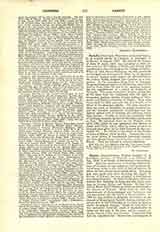

Carnoy, JEAN-BAPTISTE, Belgian biologist, b. at Rumillies, province of Hainaut, near Tournai, January 22, 1836; d. at Schuls, in Switzerland, September 6, 1899. After the usual course in theology at the seminary of Tournai, he was ordained priest and then devoted some years to the study of natural science, for which he had always shown great talent. His progress was rapid and, after receiving the degree of Doctor of Science, he was awarded a Government travelling fellowship. He went to Germany, where he worked with Hanstein at Bonn and also spent some time in Leipzig, Berlin, and Vienna. He was then sent to Rome by his bishop on business pertaining to the Diocese of Tournai. While there he made the acquaintance of Buoncompagni and Castracane and was associated with the latter in his researches. In 1868 he was recalled to Belgium, his bishop, at the request of Monseigneur Laforet, having consented to attach him to the University of Louvain to found a course in general biology. Financial difficulties at the university, however, made it impracticable to carry out this plan at the time, and he became, instead, vicar at Celles near Tournai. During his stay here he completed his “Recherches anatomiques et physiologiques sur les champignons” published in the bulletin of the “Societe royale de botanique”. In 1870 he was appointed cure at Bauffe, where his pastoral duties gave him little leisure for scientific work. In 1876 he was again invited to Louvain on the proposal of Monseigneur Nameche. He began his teaching with a course in practical microscopy, and in 1879 he published his “Manuel de microscopie”. This was, however, but preliminary to his work in biology, upon which his fame as a teacher and investigator rests. But instead of taking the whole science for his field he confined himself to that phase of it which seemed to him of greatest interest and importance, viz. the study of the structure and phenomena of the cell. He thus became the founder of the school of cellular biology or cytology at Louvain—the first of its kind—whose laboratories he equipped at his own expense. He gathered about him students whom he inspired with his own enthusiasm, and he spared no pains or labor to advance his school and its work and to secure recognition for it. In 1884 he founded “La Cellule”, a journal of cytology, in which much of his own work and that of his collaborators was published. Carnoy did much to advance our knowledge of the cell. He advocated Fromman’s theory of the reticulated structure of the cell, and appears to have been the first to explain the true nature of the albuminoid membrane. He devoted considerable study to the nucleus and was able to distinguish three species of nucleoli within the nucleus, differing in structure and function. He also carried on important researches in cell segmentation. Besides the works already mentioned, Carnoy was the author of the “Traite de biologie cellulaire” (1884), an important work, which, however, was never completed.
H. M. BROCK

